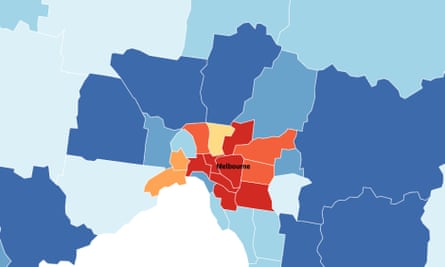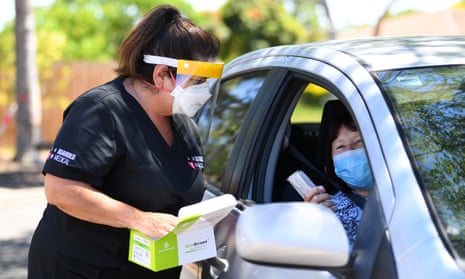Covid cases are rising again in several Australian states, most rapidly in Western Australia, though the spike there has not been accompanied by a rise in severe disease.
WA has recorded 29,839 total cases over the pandemic, but 17,641 of those were recorded in just the last seven days. Meanwhile New South Wales, Tasmania, South Australia and the Australian Capital Territory have also reported a rise in cases over the past week, though much less steep.
Dr Michael Lydeamore, an infectious disease modeller and epidemiologist with Monash University in Melbourne, said the rises were unsurprising. In WA, testing rates are strong. But despite the rising case numbers, no one is in intensive care.
“There is data that says infection-inquired immunity is strong in places like NSW and Victoria, and that exposure gives you protection,” Lydeamore said.
“There were certainly stories of people in NSW getting 15 close contact notifications a week from the check-in app. WA hasn’t had that level of exposure to the virus. They’re relying only on vaccine protection which is good, but they’re also slightly behind on their general vaccine program, including the rollout of boosters.
“There is also no lockdown in WA. I’m not suggesting they should have one, but most other places had strict restrictions when cases took off.
“So I am not surprised by the spike in numbers, but the important thing is that these cases aren’t translating into a big increase in people getting severe disease [and] requiring hospital care or worse. That speaks to vaccine success.”
As for rises in other states, Lydeamore said a combination of factors were working together such as: a return to school; the growing prevalence of BA.2, a more infectious sub-variant of Omicron which is also increasing in WA; and more movement generally as restrictions ease and people return to offices.
Across the country, there has also been a sharp rise of 10 to 19-year-olds with Covid-19, with cases in this age group comprising over 20% of all infections in recent days. The return to schools was driving this, not just in terms of spread, but because states and territories have rapid-antigen testing programs and other requirements in place for schools, which mean more cases in young people are being detected.
While the compulsory RAT program in NSW has been dropped, RAT testing kits are still being offered to families who want them.
“The probability of detecting cases in children is now much higher,” Lydeamore said.
There have also been rises in cases in specific local government areas in Melbourne, bucking the trend of declining case numbers in most areas.
Melbourne reported 485 cases in the last seven days compared with 311 in the previous seven. Eastern and south-eastern suburbs reported similar trends, including Boroondara, which rose to 538 cases in the past seven days compared with 401 cases the week prior, Stonnington which jumped to 281 cases from 194, and Glen Eira where cases jumped to 581 from 443.

“All of those areas are fairly affluent, which is associated with more travel and movement,” Lydeamore said.
“It’s possible now that travel overseas is available people are also bringing Covid back. The other thing, of course, is that there are also a large number of people who were working from home in those suburbs, and now they’re not. And workplaces are a great place for transmission.”
A spokesperson for the Victorian department of health said case numbers fluctuate for a variety of reasons including increased movement associated with more people returning to work and attending school.
“This is the first time the number of Covid-19 cases in hospital in Victoria has been below 200 since 16 September last year,” they said.
NSW recorded 13,179 positive test results on Wednesday, with the Western Sydney and Northern Sydney local health districts recording the highest number of cases.
